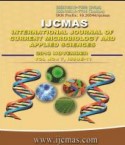


 National Academy of Agricultural Sciences (NAAS)
National Academy of Agricultural Sciences (NAAS)

|
PRINT ISSN : 2319-7692
Online ISSN : 2319-7706 Issues : 12 per year Publisher : Excellent Publishers Email : editorijcmas@gmail.com / submit@ijcmas.com Editor-in-chief: Dr.M.Prakash Index Copernicus ICV 2018: 95.39 NAAS RATING 2020: 5.38 |
The genetic diversity of maize inbred lines were analyzed by using D2 statistics during kharif, 2015 in Randomized Block Design (RBD) at TCA, Dholi farm of Dr. Rajendra Prasad Central Agricultural University, Pusa, Bihar, with eighteen inbred lines of maize derived from different maize populations. Results indicated that ANOVA for mean sum of squares due to inbred lines were significant for ten characters except for days to flowering, days to brown husk and girth of ears, indicating scope for selection of promising genotypes for yield improvement. The genetic divergence on the basis of ten quantitative characters was analyzed using Mahalanobis D2 statistics. All the genotypes were grouped into five clusters. The average intra cluster distance ranged from 1.91 to 4.23. The maximum intra cluster distance was observed in cluster V (4.23). The highest inter cluster distance was observed in between Cluster I and V (36.99), followed by cluster I and IV (31.91), Cluster I and II (23.67), Cluster III and V (15.89), Cluster III and IV (13.56). Inbred lines from these clusters may be selected as parents for hybridization programme for developing new hybrid combinations. Ear height, ear length, ear girth, number of kernel rows per ear and grain yield showed maximum values in cluster V, therefore, selection of parents from cluster V may be done for desired traits. Percent contribution of number of kernels/row (60.78%) to total divergence was found maximum.
 |
 |
 |
 |
 |